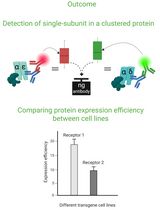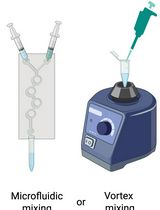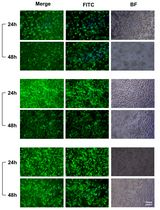- EN - English
- CN - 中文
Well Plate–Based Localized Electroporation Workflow for Rapid Optimization of Intracellular Delivery
基于多孔板的局部电穿孔流程用于快速优化细胞内递送
发布: 2024年07月20日第14卷第14期 DOI: 10.21769/BioProtoc.5037 浏览次数: 1424
评审: David PaulRosario Gomez-GarciaNeha Agarwal

相关实验方案

Cluster FLISA——用于比较不同细胞系蛋白表达效率及蛋白亚基聚集状态的方法
Sabrina Brockmöller and Lara Maria Molitor
2025年11月05日 604 阅读
Abstract
Efficient and nontoxic delivery of foreign cargo into cells is a critical step in many biological studies and cell engineering workflows with applications in areas such as biomanufacturing and cell-based therapeutics. However, effective molecular delivery into cells involves optimizing several experimental parameters. In the case of electroporation-based intracellular delivery, there is a need to optimize parameters like pulse voltage, duration, buffer type, and cargo concentration for each unique application. Here, we present the protocol for fabricating and utilizing a high-throughput multi-well localized electroporation device (LEPD) assisted by deep learning–based image analysis to enable rapid optimization of experimental parameters for efficient and nontoxic molecular delivery into cells. The LEPD and the optimization workflow presented herein are relevant to both adherent and suspended cell types and different molecular cargo (DNA, RNA, and proteins). The workflow enables multiplexed combinatorial experiments and can be adapted to cell engineering applications requiring in vitro delivery.
Key features
• A high-throughput multi-well localized electroporation device (LEPD) that can be optimized for both adherent and suspended cell types.
• Allows for multiplexed experiments combined with tailored pulse voltage, duration, buffer type, and cargo concentration.
• Compatible with various molecular cargoes, including DNA, RNA, and proteins, enhancing its versatility for cell engineering applications.
• Integration with deep learning–based image analysis enables rapid optimization of experimental parameters.
Keywords: Electroporation (电穿孔)Background
Intracellular delivery of molecular cargoes allows for a wide variety of cell manipulation tasks with applications ranging from cell engineering and gene editing to cell therapy [1,2]. Given the wide implications of intracellular delivery for fundamental biology research and therapeutics, several technologies have emerged to achieve this task with high efficiency and precision that can be classified into two broad categories: i) direct delivery and ii) carrier-mediated delivery [3]. In direct-delivery methods, the cell membrane is permeated by subjecting it to physical disturbances such as mechanical forces [4–7], electric fields [8–10], or thermal shock [11]. Conversely, carrier-mediated delivery methods rely on chemical interactions between the cell membrane and the nanocarrier, which trigger endocytosis and encapsulation of the molecular cargo [3]. Examples of nanocarriers include lipid vesicles [12], spherical nucleic acids [13], and polymer nanoparticles [14]. Direct delivery methods offer more control and tunability over the membrane permeation process, which can result in tighter dosage precision compared with carrier-mediated methods [1,15].
Electroporation is one of the most widely used direct-delivery methods because of its ease of use and high throughput. In bulk electroporation systems, cells are placed in a cuvette with embedded electrodes that subject a suspension of cells to an electric field that induces the formation of pores across the cells when the electric potential across the membrane [transmembrane potential (TMP)] reaches a certain threshold. However, high applied voltages are required to achieve threshold TMP in bulk electroporation systems, which results in high cell mortality. Furthermore, the variability in the spatial distribution of the cells in the cuvette results in heterogeneous electric field conditions from cell to cell, which reduces dosage precision [1]. To circumvent these limitations, researchers developed electroporation systems that confine the electric field to a small fraction area of the cell membrane by interfacing cells with nanoscale orifices prior to the application of electric pulses [9,16,17]. The resulting highly localized electric fields enable the application of much lower voltages compared to bulk systems to achieve threshold TMPs, which results in higher viability. Examples of nanoscale features used in localized electroporation systems include nanochannel membranes [18,19], nanopipettes [20], nanostraws [21], and nanofountain probes [22].
Localized electroporation systems have been shown to be efficient in delivering various payloads (e.g., nucleic acids, plasmids, proteins, and nanoparticles) as well as sampling intracellular contents from cells [23,24]. The performance of localized electroporation systems depends on the electric field conditions, the mechanical properties of the cell membrane, the ionic environment in the surrounding fluid, and the physical properties of the molecular cargo (i.e., size and charge) [2,3]. While these systems offer significant advantages, they also pose challenges in scalability in the number of cells and require high cargo concentrations, which may limit their applicability in certain scenarios. Consequently, several parameters must be optimized to achieve the desired electroporation performance, including both delivery efficiency and cell health. To expedite the optimization process, we designed a well plate–based localized electroporation device (LEPD) equipped with multiplexing capabilities [9]. The multi-well LEPD system allows for tunability in the electric pulse conditions across the rows of the device and the molecular cargo or buffer conditions across columns. Furthermore, we integrated the LEPD with automated imaging and deep-learning enhanced segmentation to analyze the morphology of cells following delivery in addition to delivery efficiency and viability. The integrated approach provides a flexible platform suitable for adherent or suspended cell manipulation and analysis. In this protocol, we detail the experimental workflow of the LEPD spanning from device fabrication to optimization of plasmid delivery.
Materials and reagents
Well-plate electrode assembly
Custom printed circuit board (PCB) with gold electrode pads (Infinitesimal LLC, infinitesimal.llc.hde@gmail.com)
Custom PCB with through-holes (Infinitesimal LLC, infinitesimal.llc.hde@gmail.com)
Push-fit PCB receptacle (Mill-Max, catalog number: 0350-0-15-15-07-27-10-0)
Au-coated pins (straight pin or nail-head pin) (Mill-Max, catalog number: 3580-1-00-15-00-00-03-0)
Bottomless well plate (Greiner Bio-One, catalog number: 662000-06)
Biopsy punch, 12 mm (Acuderm, catalog number: P1250)
Double-sided pressure adhesive tape (Adhesives Research, catalog number: MH-90880)
Cutting board
Razor blade
Marker
Device assembly
Track-etched polycarbonate (PC) membranes (Itpi4, catalog number: 1000M25/620N401/7525)
Cloning cylinders (Millipore Sigma, catalog number: CLS31668)
Double-sided pressure adhesive tape (Adhesives Research, catalog number: MH-90880)
Biopsy punch, 6 mm (Miltex, catalog number: 33-36)
Acetone (Sigma-Aldrich, catalog number: 179124)
70% EtOH/H2O
Nitrogen (N2) (Airgas, catalog number: UN1066)
Oxygen (O2) (Airgas, catalog number: UN1072)
Scissors
Electroporation: low conductivity electroporation (EP) buffer (Eppendorf, catalog number: EW-36205-62)
Surface treatment and cell culture
Fibronectin from human plasma (0.1% solution) (Sigma-Aldrich, catalog number: F0895)
Dulbecco’s modified Eagle medium (DMEM), high glucose, pyruvate (Gibco, catalog number: 11995065)
Fetal bovine serum (FBS) (Gibco, catalog number: A3160501)
Penicillin-Streptomycin (Pen-Strep) (10,000 U/mL) (Gibco, catalog number: 15140148)
Trypsin-EDTA (0.25%), phenol red (Gibco, catalog number: 25200056)
NuncTM cell culture–treated multi-dishes, 6-well plates (Thermo Fisher Scientific, catalog number: 140675)
Phosphate buffered saline (PBS) (Gibco, catalog number: 10010023)
HeLa cells (ATCC, catalog number: CCL-2)
Plasmid: eGFP plasmids (Addgene, stock concentration 1,000 ng/μL)
Automated imaging: Hoechst 33342 nuclear stain (Invitrogen, catalog number: H3570)
Equipment
Electronics box for pulse generation and resistance measurements along with pulse control software (Infinitesimal LLC, infinitesimal.llc.hde@gmail.com)
Inverted microscope (Nikon Ti-E) equipped with 4×, 10×, and 20× objectives, fluorescent light source, an epi-filter cube with a DAPI filter, XYZ motorized stage, and a CMOS camera (Andor Zyla) for image acquisition
Computer for setting pulse parameters and image processing
Laboratory centrifuge (Thermo Fisher Scientific, catalog number: 75007200)
Sonicator (Ultrasonic Cleaning Bath, Branson, catalog number: 3800)
Oxygen plasma cleaner (Harrick Plasma, catalog number: PDC-32G)
Procedure
文章信息
稿件历史记录
提交日期: May 23, 2024
接收日期: Jun 3, 2024
在线发布日期: Jul 5, 2024
出版日期: Jul 20, 2024
版权信息
© 2024 The Author(s); This is an open access article under the CC BY license (https://creativecommons.org/licenses/by/4.0/).
如何引用
Readers should cite both the Bio-protocol article and the original research article where this protocol was used:
- Patino, C. A., Sarikaya, S., Mukherjee, P., Pathak, N. and Espinosa, H. D. (2024). Well Plate–Based Localized Electroporation Workflow for Rapid Optimization of Intracellular Delivery. Bio-protocol 14(14): e5037. DOI: 10.21769/BioProtoc.5037.
- Patino, C. A., Pathak, N., Mukherjee, P., Park, S. H., Bao, G. and Espinosa, H. D. (2022). Multiplexed high-throughput localized electroporation workflow with deep learning–based analysis for cell engineering. Sci Adv. 8(29): eabn7637.
分类
分子生物学 > 纳米颗粒 > 植物源纳米颗粒
力学生物学
生物化学 > 蛋白质 > 表达
您对这篇实验方法有问题吗?
在此处发布您的问题,我们将邀请本文作者来回答。同时,我们会将您的问题发布到Bio-protocol Exchange,以便寻求社区成员的帮助。
提问指南
+ 问题描述
写下详细的问题描述,包括所有有助于他人回答您问题的信息(例如实验过程、条件和相关图像等)。
Share
Bluesky
X
Copy link











